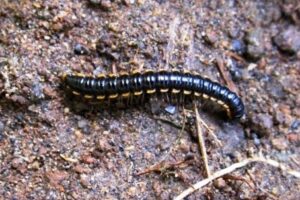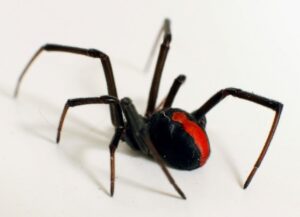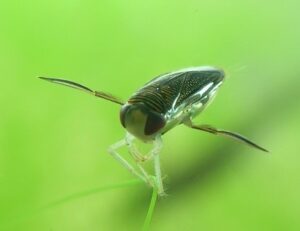
Occasional invaders, light-attracted pests, and miscellaneous pests are encountered by pest management professionals. Occasional invaders are those pests that often occur in buildings at some stage of their life cycle, but that does not usually complete their entire life cycle within the building. This means that pests living outside of buildings come indoors only on occasion and do-little damage, and are considered a nuisance simply because of their presence.
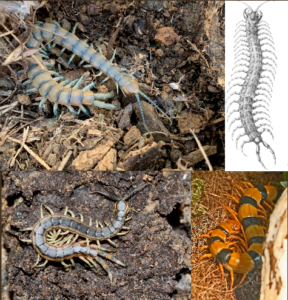
Light-attracted pests enter buildings while they are flying at night because they are attracted to lights (in or on the home or building), while miscellaneous pests are those that usually complete their life cycle within the building. The distribution of these pests varies. They are either common in many parts of the country or may occur in large numbers only in certain regions. Some pests cause extensive damage to household goods and furnishings, while others are venomous or cause allergic reactions.
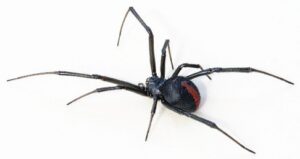 Factors that may stimulate pest movement into structures include (1) the outdoor lighting, and manipulation of lighting can give the most satisfactory long-term relief against the light-attracted pests, (2) excessive rainfall (poor drainage adjacent to the foundation), (3) lower temperatures (few pests seek to overwinter in structures), or (4) the presence of some unusual food source within the structure. Removing the source that causes an entry of the pests is a good recommendation to be given to the customer to prevent future infestation of these pests.
Factors that may stimulate pest movement into structures include (1) the outdoor lighting, and manipulation of lighting can give the most satisfactory long-term relief against the light-attracted pests, (2) excessive rainfall (poor drainage adjacent to the foundation), (3) lower temperatures (few pests seek to overwinter in structures), or (4) the presence of some unusual food source within the structure. Removing the source that causes an entry of the pests is a good recommendation to be given to the customer to prevent future infestation of these pests.
ETS professionals are qualified to identify these pests, understand their habits, and make a proper assessment of the factors causing the problem. No one general management method exists for all these pests, and there are many non-chemical pest management procedures when dealing with these types of pests (sanitation procedures, basic change in landscaping, exclusion techniques, etc.).
The Most Common Occasional Invaders in UAE:
- Backswimmers (Family Notonectidae, Order Hemiptera)
Common Backswimmer – Notonecta glauca (Linnaeus)
- Booklice or Psocids: (Family Liposcelididae, Order Psocoptera)
Booklouse or Psocid – Liposcelis corrodens Heymons)
- Bumble Bees (Family Apidae, Order Hymenoptera)
Red-Tailed Bumblebee – Bombus lapidaries (Linnaeus)
- Centipedes (Family Scutigeridae, Order Scutigeromorpha)
A – Forty-Four-Legged Lady – Scolopendra mirabilis Porat
B – House Centipede – Scutigera coleoptrata Linnaeus
- Crickets (Family, Order)
A – House Cricket – Acheta domesticus (Linnaeus)
B – Field Cricket – Gryllus campestris (Linnaeus).
- Earwigs (Family Labiduridae, Order Dermaptera)
A – Striped Earwig, Riparian Earwig, or Common Brown Earwig – Labidura riparia (Pallas) B – Common European earwig – Forficula auricularia Linnaeus
- Firebrats (Family Lepismatidae, Order Thysanura)
Common Firebrat – Thermobia domestica Packard
- Honey Bees (Family Apidae, Order Hymenoptera)
Honey Bee – Apis mellifera Linnaeus
- Millipedes (Family Paradoxosomatidae, Order Polydesmida)
Long-flange Millipede – Orthomorpha coarctata (De Saussure)
- Plaster Beetle (Family Lathridiidae, Order Coleoptera)
Common Plaster Beetle – Dienerella filum Aubé
- Scorpions (Family, Buthidae, Order Scorpiones)
A – Arabian Fat-Tailed Scorpion or Black Scorpion – Androctonus crassicauda (Olivier)
B – Black Sting Scorpion – Buthacus yotvatensis nigroacleatus
- Silverfish (Family Lepismatidae, Order Thysanura)
Common Silverfish – Lepisma saccharina Linnaeus
- Spiders (Family Theridiidae, Order Araneae)
A – Red Back Spider or Back Widdow Spider – Latrodectus hasselti Thorell
B – Common House Spider – Parasteatoda tepidariorum (C.L. Koch)
- Springtails or Snow Fleas (Order Collembola)
Common Springtail or Snow Flea
- Wasps (Family Vespidae, Order Hymenoptera)
A- Paper Wasp – Polistes Polistes dominula Christ
B – Oriental Wasp – Vespa orientalis Linnaeus
- Water Boatmans (Family Corixidae, Order Hemiptera)
Lesser Water Boatman – Corixa punctata (Illiger)
- Yellowjackets (Family Vespidae, Order Hymenoptera)
German Yellowjacket or German Wasp – Vespula germanica (Fabricius)
Click on each pest to learn about its general description, life cycle, common characteristics, damages, and economic or health implications.
- Backswimmers:
Common Backswimmer
General Description
| · The most easily identifiable feature of notonectids is their long hind legs that are used to propel themselves in the water.
· Adults have pale tan heads and legs. The pronotum is darker than the head and the elytra (hardened forewings) can be a range of tan colors. |
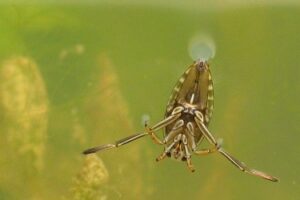
Credit: Holger Gröschl |
- Females have a larger body size compared to males.
- The eyes are large and dark red in color.
- Fully-grown adults measure about 16 mm.
- Eggs have white oblong eggs and are found attached to aquatic vegetation.
- Nymphs look like small adults. They do not have fully developed wings as nymphs, and they have much shorter abdomens. They are often more uniform in color and their pronotum is not darker than the rest of the body, as seen in the adults.
Life Cycle and Common Characteristics
- It is a species of aquatic insect
- These water insects swim and rest on their back or upside down (hence their common name “backswimmer”) and are found under the water’s surface.
- Adults lay eggs in the fall and or spring.
- They have five nymphal instars that develop over the summer months.
- It supports itself under the water’s surface by using its front legs and mid legs and the back end of its abdomen and resting them on the water’s surface.
- Although they live in the water, they breathe atmospheric air and do not have gills.
| · When they are diving or resting under the water’s surface, they create a film of air that surrounds their body.
· Males and females both spend a lot of time on the surface of the water where they encounter mosquito larvae. · Mature females dive to the bottom of the pond to feed on isopods, but only in shallow waters. |

Credit: E. van Herk |
- Mature females have a larger abdominal size, which could support a larger air bubble and allow them to remain submerged for longer.
- They inhabit still freshwater, e.g. lakes, ponds, and marshes, and are sometimes found in garden ponds and even swimming pools
- There is only one generation a year.
Damages and Economic & Medical Implications
- They can inflict a painful “bite” on a human being, actually a stab with their sharp tubular mouthparts (proboscis).
- Booklice or Psocids:
Booklouse or Psocid
General Description
| · The adult is small, with a soft body, 1-2 mm long, and has a yellowish-honey color.
· The mouth parts are biting. The head carapace is divided into a small anterior carapace and a large posterior carapace. |

Credit: USDA-ARS |
- The horn of consultation is threadlike, consisting of 12-17 knots.
- They have no wings and only simple eyes.
Life Cycle and Common Characteristics
- Females lay eggs singly or in groups, and the amount laid by one female reaches from 20-100 eggs.
- The egg is oval in shape and white in color. The eggs hatch into white, static nymphs that moult 4 times until turning into the full insect.
- The insect has 6-8 generations per year.
- It is characterized by its great speed in moving around the places of its injury.
- It prefers to be in dusty places where the humidity and heat are high, such as libraries, neglected cupboards, gaps and cracks in walls, and behind electricity and drainage connections.
- It feeds on microscopic rotting fungi found in plant materials found in books (glue, starchy materials, papers) and furniture.
Damages and Economic & Medical Implications
- When present in large numbers, it causes damage to books, documents, pictures and other paper products. It crawls over everything it encounters in the home and pollutes food, especially starchy foods, so it is seen as an annoying household pest.
- Bumblebees:
Red-Tailed Bumblebee
General Description
| · Queens and workers are black, with a bright red tail covering half of the abdomen.
· Males have yellow facial hair and bright yellow bands at the front and rear of the thorax, along with a similar red tail to females. · They are distinguished by their black body with red markings around the abdomen. · Worker females and the queen look similar, but the queen is larger than the workers. |
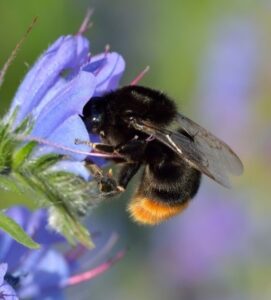
Credit: Ivar Leidus |
- Males have red and black coloration along with a yellow band around the abdomen.
- Yellow markings are present on the face.
Life Cycle and Common Characteristics
- Bumble bees appear in the summer months (June to August).
- These bees do not form complex colonies.
- The queen establish the new colony.
- Nests usually only contain a few hundred bees.
- A colony consists of 150 to 300 workers.
- Nests are found in different habitats, but the bees prefer open terrain.
- Being social bees, they produce heat, due to the contraction of their thoracic flight muscles, to help warm and incubate their brood.
- Males travel a greater distance than workers.
- They eat pollenand nectar.
- Workers attempt to eat the eggs laid by the queen, but the queen cannot prevent this from happening.
Damages and Economic & Medical Implications
- These bumblebees are important for pollination for many plants.
· They have the ability to sting.
- Centipedes:
A – Forty-Four-Legged Lady
General Description
| · The forty-four-legged lady vary considerably in coloration and size.
· colopendra centipedes are large centipedes and vary in coloration and size. · It is the largest species found in tropical climates can exceed 30 cm and are the largest living centipedes in the world. |
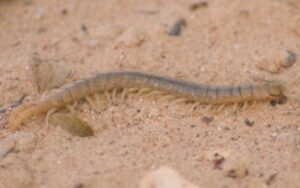
Credit: P. Roosenschoon, DDCR |
- It has a drab coloration combining shades of brown and light brown.
- It has an elongated body with one pair of legs attached to most of the body segments. It differs from millipedes in that millipedes have two pairs of legs on most segments and bodies that are not flattened.
- Centipedes have a flattened, segmented body, long antennae, and many legs. This species has 19 segments (most individuals have 15). Each body segment has a pair of legs, and it regenerate legs if it is cut off. The last pair of legs is modified to have pincers, mainly to defend them from other predators.
- Centipedes have a pair of poison claws behind the head and use their poison to paralyze prey, usually small insects. However, the jaws of centipedes are weak and can only rarely penetrate human skin.
- The body is divided into two parts, the head, and a segmented trunk. They breathe through spiracles, holes positioned along the side of the abdomen, easily seen as black dots.
Life Cycle and Common Characteristics
- Egg laying occurs in spring and summer and the breeding usually takes place in late winter and early spring.
- Eggs (10-15 at a time) are laid singly in holes in the soil; the female fills the hole in on the egg and leaves it. The surface of the egg is covered with a sticky film to which soil particles adhere to form a protective layer.
- Centipedes overwinter as adults where there is adequate shelter within their immediate environment.
- Scolopendra centipede can be found in wood piles, baseboards of wooden fences, beneath ornamental bark, or baseboards of wooden fences.
- They usually live outdoors in damp areas, such as under leaves, stones, boards, or tree bark, or in mulch around outdoor plantings.
- If provoked, larger centipedes may bite, causing some pain and slight swelling. These “bites” are not caused by their jaws or mouthparts – rather,
- it’s their front legs, which are modified to look and function like jaws, that contain the venom glands.
- Scolopendra are predators of other arthropods and small vertebrates. The first pair of legs (“toxognaths”) in the scolopendrids are specialized for injecting venom. Larger individuals have been observed preying on frogs, lizards, birds, snakes, rodents, and even bats.
- Centipede sex does not involve copulation. Males deposit a spermatophore for the female to take up. In one case, this spermatophore is deposited in a web, and the male undertakes a courtship dance to encourage the female to engulf his sperm. In other cases, the males just leave them for the females to find.
Damages and Economic & Medical Implications
- Scolopendra do not damage household furnishings or food supplies.
- They are beneficial; they feed on insects, spiders, and other arthropods.
- Most people consider them a nuisance when they wander indoors.
- Smaller species are not large enough to penetrate human skin, and their bites are not serious (but an antiseptic should be used on the wound).
- The venom is not medically significant for most species of the genus The bites from several species can cause intense and long-lasting pain and swelling.
- The venom of certain species contains compounds such as serotonin, haemolytic phospholipase, a cardiotoxic protein, and cytolysin.
B – House Centipede
General Description
| · The body of this centipede is only 2.5-3.5 cm long, but with its 15 pairs of delicate, long legs make it seem much larger (7.5-10.0 cm long).
· The body is grayish-yellow with three dark stripes extending along the full length of the back.
|

Credit: Filip.vidinovski |
- The delicate legs enable it to reach surprising speeds of up to 0.4 meters per second running across floors, up walls, and along ceilings.
- House centipede has developed automimicryin that its tail-like hind legs present the appearance of antennae.
- Unlike most other centipedes, house centipedes have well-developed faceted eyes.
Life Cycle and Common Characteristics
- Unlike other centipedes, this species lives its entire life inside a building.
- In homes, they prefer to live in damp and undisturbed areas, such as cellars, closets, bathrooms, attics, and unexcavated areas under the house.
- Eggs (about 150) are laid in the spring in damp places, behind baseboards, or beneath bark on firewood.
- Centipedes develop by gradual metamorphosis, so immatures have a similar appearance to adults but are smaller.
- All life stages run rapidly across floors or accidentally trapped in bathtubs, sinks, and lavatories.
- They forage at night for small insects and other arhropods.
- Young centipedes have 4 pairs of legs when they are hatched. One new pair appear after the first molt, and 2 pairs after each of their 5 subsequent molts.
- Adults with 15 pairs of legs retain that number through three more molting stages.
- House centipedes live anywhere from 3 to 7 years, depending on the environment.
- Mating starts by circling around each other and touching their antennae. Then the male deposits his sperm on the ground for the female to use it to fertilize her eggs.
- House centipedes feed on spiders, bed bugs, termites, cockroaches, silverfish, ants, and other household arthropods.
- They are mostly nocturnal They rely mostly on their antennaewhen hunting, and on their mandibles and legs to hold their prey.
- If they are in danger of becoming prey themselves, they can detach any legs that have become trapped.
- House centipedes groom their legs by curling around and grooming them with their forcipules.
- If found outdoors, they prefer to live in cool, damp places (under large rocks and piles of wood or leaves).
- They are sensitive to daylight and very sensitive to ultraviolet light.
Damages and Economic & Medical Implications
- House centipedes inject venomthrough forcipules, which are not part of their mandibles, so strictly speaking they sting rather than bite.
- They sting but their jaws are quite weak. If a sting occurs, a slight swelling is shown.
- Centipedes do not damage food supplies or household furnishings.
- They are beneficial insects because they feed on insects and other arthropods. Most people consider them a nuisance when they wander indoors and insist that they be eliminated.
- Crickets:
A – House Cricket
General Description
| · Adults are 1.7-2.3 cm in length, with long, thin antennae that is longer than the body. The body is light yellowish brown, with three dark bands on the head. The wings lie flat on its back.
· Nymphs are 16-21 mm in length. The body is gray or brownish in color, and wingless but otherwise look similar to adults. · Males and females look similar, but females will have a needle from the rear, around 1.2 cm long. |
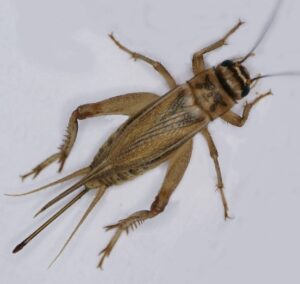
House Cricket – Credit:Geyersberg
|
- The ovipositor is brown-black, and is surrounded by two appendages.
- On males, the cerci are also more prominent.
Life Cycle and Common Characteristics
- Eggs are deposited in damp substrate if available.
- Nymphs resemble the adults except for being smaller and wingless.
- Adults take two to three months to complete their life cycle.
- They have no special overwintering stage, but can survive cold weather in and around buildings, and in dumps where heat from fermentation may sustain them.
- This cricket is active at night, usually remaining hidden during the day.
- They live outdoors but may invade houses in great numbers.
Damages and Economic & Medical Implications
- They are omnivorous, eating or drinking almost anything that is available.
- In households, they may chew on or damage silk, woollens, paper, fruits, and
- Outdoors, they consume flowers, seeds, leaves, fruits, grasses, and other insects
B – Field Cricket
General Description
| · Field crickets are flightless dark brown to gray or blackish.
· They are comparatively large; the males range from 1.9 to 2.3 cm and the females from 1.7 to 2.2 cm. · Field crickets are larger than house crickets and have wings extending beyond the wing covers. |
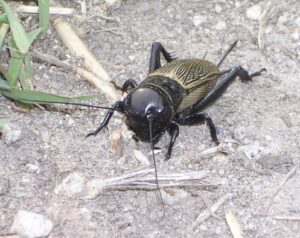
Credit: Roberto Zanon |
Life Cycle and Common Characteristics
- The mating season lasts from May to July.
- The males make a burrow in the soil and wait at the entrance to attract females for mating.
- Nymphs hatch in June till mid-July and hibernate during their 10th or 11th The final molt takes place from April or early May.
- Females are vagrant and attracted by singing males, while males defend their burrows fiercely.
- They lay their eggs in the bare ground either inside or close to a burrow.
- Nymphs, after egg hatching, molt at least 8 times before they become adults.
- Field crickets frequently invade houses and other structures, and may feed on organic matter in the soil or a wide variety of materials.
- They prefer to live outdoors to feed on soft plant parts, but they move inside when environmental conditions outdoors become unfavorable. Individuals are unlikely to survive more than 2 weeks indoors.
- They prefer sunny locations with short vegetation.
- The species is flightless and unable to migrate long distances.
- They practice cannibalism if they are very hungry.
Damages and Economic Implications
- Field crickets are often attracted to lighted areas at night, and may enter buildings. Their infestation can be loud and annoying as these omnivorous insects feed on anything from plants to paper to clothing.
- Earwigs:
A – Striped Earwig, Riparian Earwig, or Common Brown Earwig
General Description
| · Small in size, up to 5.5 cm in length (average of 2.5 cm).
· Their color is usually black or brown, and some species in hot regions have bright colors. · The striped earwig is lighter in color than the other earwigs, and the pronotum and front wings are usually marked with pale stripes along the edges and in the middle. · At the back of the abdomen there is a forceps-like structure that earwigs use for defense and seizing prey. |

Credit: Hans Hillewaert |
Life Cycle and Common Characteristics
- The female lays 60-100 eggs and lay over top of the eggs much like a hen. They stay with the eggs for 10 days until they begin to hatch.
- The female searches for food for her young until they leave the nest themselves 2–5 days later.
- The young go on to dig their own nest for molting taking anywhere from 4 to 50 days to reach the next instar, repeating to a total of 6 instars before adulthood.
- Adults live for only 2–3 months and begin courting immediately.
- There are 2-3 generations per year, with the last generation hibernating underground through winter.
- Earwigs are nocturnal insects that hide during the day under stones and among plant leaves, or in cracks in the soil. It is also active at night and is attracted to light.
- They are propelled by three pairs of articulated legs.
- Mouth parts are biting; Therefore, the insect feeds on the garbage and live animal matter such as flies and other insects and dead animal matter. The anal pods are mutated into tweezers used to catch prey.
- This insect has the ability to develop large populations within a single season, and it can be a severe pest where land is being cleared for new buildings.
- Earwig populations often build up in areas around foundations.
- In the foundation perimeter, they are especially common at the juncture of any stone elements with the soil.
- They produce a strong odor when disturbed or crushed.
- Earwigs use these forceps to assist in predation, defense, sexual selection, mating, and wing folding.
- The striped earwig prefers dark, moist environments with a shelter that it can hide in during the daytime.
Damages and Economic & Medical Implications
- Striped Earwigs are harmfulor dangerous. These are essentially nuisance pests.
- It is considered a pest of gardens and homes.
- They are generalist predators whose diet consists entirely of insects or scavenged meat.
B – Common European earwig
General Description
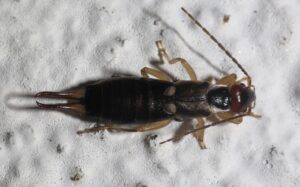
Female. Credit: Luis Miguel Bugallo Sánchez |
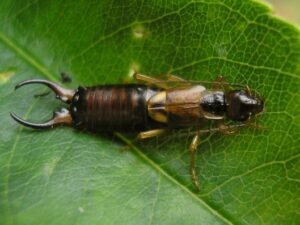
Male. Credit: Pudding4brains |
- The European earwigs are about 1.2–1.5 cm long.
- They have elongated flattened brownish-colored bodies, with scissor-like tail.
- They have two pairs of wings and a pair of forceps-like cerci.
- The antenna consists of 11–14 segments, and the mouth parts are of the chewing type.
- Adult males are polymorphicin body weight and head width, as well as cercus length and width.
- The male forceps are robust and broadened, while the female forceps are about 3 mm long and are less robust and straighter.
- The cerci are used during, feeding mating, and self-defense.
Life Cycle and Common Characteristics
- A male finds prospective mates by olfaction (smelling).
- The mating process occurs frequently among clustered individuals.
- A single mating enable the female to lay fertilized eggs.
- The female earwig lays a clutch of about 50 eggsin an underground nest in the autumn.
- The female enters a dormant state about 5 mm below the surface of the ground and stays in the nest with the eggs.
- Adults survive in cool, moist habitats.
- They spend the daytime living on organic matter and waste found in the soil around plants and feed on some plant tissues such as flowers, fruits, and buds, insects, and the remains of dead animals.
- They appear at night in the desert, gardens, and houses near gardens.
Damages and Economic & Medical Implications
- Common European earwigs cause significant damage to crops, flowers, and fruit orchards when at high population levels.
- They are considered beneficial insects for their use in the pest management of other insects. They are natural predators of a number of other agricultural pests,
- Humans are not very fond of common earwigs because of their foul odor and annoying propensity to aggregate together in or near human dwellings.
- There is no indication in scientific sources of the toxicity of this insect and its effect on humans, except that it stings similar in effect to the pain of a bee sting.
- They may parasitize the habitats of bats and mice and may be vectors for diseases transmitted by these types of mammals.
- One of the myths and legends of Europeans is that earwigs crawl to enter the human ear and feed on the eardrum, and for this reason, it is called in some sources ear piercing or ear insect. The superstition goes that this insect only enters the ear of the elderly, and that is why it was called (the old man’s needle).
- Firebrats:
Common Firebrat
General Description
| · The body of an adult firebrat is about 1- 1.25 cm long and marked on the back with numerous dark patches that give the firebrat a mottled gray appearance.
· It is a wingless insect. The young look like small adults.
|
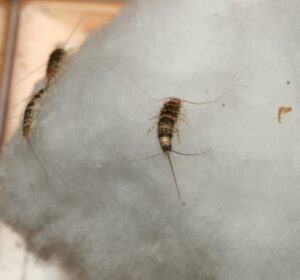
Credit: Klemens Bottig |
Life Cycle and Common Characteristics
- The female aged 5 to 4.5 months begin laying eggs (at 32–41 °C). It can lay up to 6000 eggs in a lifetime of about 3–5 years.
- Egg incubation lasts for 12–13 days.
- Afteregg hatching, the nymphs reach maturity in 2 to 4 months.
- There are several generations each year.
- Common firebrats are most active at night and can run very swiftly.
- The firebrats live under rather unusual conditions, generally in areas not frequented by silverfish. They live outdoors under rocks, bark, and leaf litter, in the nests of birds and mammals, in ant and termite nests, and in similar environments. They are also found indoors in areas associated with heat, such as boiler rooms, or moisture, such as near water pipes. They are found in bathtubs, where they are trapped while seeking food or moisture.
- Firebrats prefer higher temperatures and can be frequently found around ovens or in bakeries and near boilers or furnaces, boiler rooms or tunnels containing steam pipes. They also require some humidity.
- The feeding behavior and preferences of common firebrats are similar to silverfish. They feed on carbohydrates and starches that are also protein sources such as flour, book bindings, dog food, and other materials.
Damages and Economic & Medical Implications
- Firebrats are mostly harmless, but nuisance insects. They do not cause major damage, but they consume small amounts of human foods and contaminate them with their body scales and droppings.
- They can do considerable damage to some natural and synthetic fibers, books and, other paper products.
- Their feeding marks are irregular, and often appear as a surface etching that may not even penetrate the paper.
· Firebrats may also leave yellow stains, especially on linens.
- Honey Bees:
Honey Bee
General Description
| · Honey bee is a social species with three adult castes: queens (only one lays eggs in each colony), drones (males), and workers (sterile females). Individual colonies may have 20,000 to 50,000 bees.
· Honey bees are of various shades of yellow, black, brown, or orange, with the head, antennae, legs, and a portion of the abdomen being dark. |

Credit: Andreas Trepte |
- The length of the queen bee is twice the length of the worker bee, its weight is three times its weight, its movement is fast, it has a stinging device and it does not die if you use it. The queen is larger than the workers and has a longer abdomen and small wings.
- The workers are covered with light-colored hairs, thickest on top of the thorax. They have a fury abdomen and are mostly black with grey stripes on the abdomen. Worker bees are usually about 1.2-1.5 cm long.
- The drone is also larger than the workers. The eyes of the male are larger than their counterparts in both the queen and the worker. They have large wings. They do not have a stinging device and are not inclined to war at all.
Life Cycle and Common Characteristics
- Social behavior is highly evolved in the honey bee. In addition to feeding the larvae, workers also amass reserve supplies of honey, which can be used as food by all the members of the colony during periods of adverse conditions.
- The bee community consists of three components: the queen, the workers, and the males.
The queen:
- The queen lays eggs that hatch into either workers or males, and she organizes the work inside the hive, starting from organizing the work of the worker bees in harvesting nectar, to making honey, and building wax disks.
- The queen lays about 1500-2000 fertilized eggs per day during the activity period (early spring and late summer). The fertilized eggs produce female workers and unfertilized males.
- The age of the queen may reach 3-7 years, while the worker is 45 days.
- Each colony of bees needs a queen, who lays eggs, binds the members of the colony together, and influences their behavior.
- Some female bees turn into queens after being fed royal jelly. After leaving her home, the virgin queen searches for the other queens and stings them
- The virgin queen flies 2-3 days after leaving the royal house to get to know her hive, and this period lasts from 4-11 minutes, and the queen chooses the awake days for fertilization, often on the fifth until the tenth day of her leaving the royal house.
The worker:
- The total number of workers in the regular hive range from 15,000 workers in the winter and early spring, and 60,000 workers in the spring and summer. The worker bees are females who have a reproductive system, but it is atrophied and unable to lay eggs. As for the egg-laying machine, it is developed into a stinging machine, and this machine ends with the touch that is used in choosing the stinging site.
- The age of the workers is about 45 days.
- The worker bees have baskets in which they collect pollen and a proboscis (mouth) with which they suck the nectar of flowers and store it in their stomach.
- The female workers raise the new queens by isolating the elderly queen. They raise one of the larvae at the age of 1-3 days or from the fertilized eggs to produce a new queen.
- Workers normally build hives in hollow trees, roof spaces, the wall cavities, or build nests hanging from tree branches.
- They feed on plant nectar and pollen. They regurgitate honey and secrete beeswax through special glands in their abdomens
The drone:
- Male bees are characterized by their lack of intelligence compared to workers.
- The mouth parts of the male are not suitable for collecting nectar, and they do not have baskets on their hind legs to collect pollen, and the male has no glands to secrete wax.
- The male’s only task is to impregnate the queen. Males do not collect nectar.
- The male takes 24 days to develop.
Damages and Economic & Medical Implications
- Honey bee is considered a pest by beekeepers and in other situations
- The first symptoms that appear after being stung are pain, redness, itching, and a high temperature at the site of the sting. At a later time, swelling and swelling may occur at the site of the sting, and sores and blisters appear. In the most serious and severe cases, itching in the throat, hoarseness, difficulty in breathing, abdominal pain, and diarrhea may arise.
- The wild or domesticated honey bees can become a serious pest when they establish a nest in or on a structure.
- If honey bees become well established within the wall voids of a house, large amounts of wax and honey may collect within the wall. If a sufficient amount of honey is inside the walls, enough may be absorbed by plaster or similar porous wall material that an unsightly, and virtually permanent stain may appear on the inside wall. In addition, the presence of honey in the wall void attracts foraging worker bees from other honey bee colonies, and also, other insects (flies, ants, and beetles) can be attracted to the nest site and may later infest other materials inside the home.
- Millipedes:
Long-flange Millipede
General Description
| · Long-flange millipede is about 1.4-2.8 cm in length (1.45–2.0.5 cm in males and 1.65–2.75 mm in females) and about 1.5-3.2 cm in width (1.5 to 2.7 cm in males and 1.6–3.2 cm in females)
|
Credit: Kembangraps |
- Millipedes are elongated dark brown to black arthropods that are oval in cross-section and appear to have two pairs of legs attached to most body segments. Actually, each apparent body segment consists of two segments that are fused together and appear as one.
- Millipedes that commonly invade homes are 1.5 to 30 cm long and tend to coil up when resting.
- The young millipedes were light brown in color.
Life Cycle and Common Characteristics
- Millipedes, also commonly known as “thousand-leggers, normally live outdoors in damp places, such as under decaying leaves and in mulch around outdoor plantings.
- They feed on damp and decaying vegetable matter, as well as on new
- roots and green leaves.
- In wooded areas, millipedes live in piles of leaf litter.
- In dry weather, they migrate out of the litter piles as the leaves dry, and they may cross roads and enter buildings in large numbers. This behavior may also occur in lawns or yards where large piles of leaves or compost piles are present.
- They can emit a foul odor when disturbed.
Damages and Economic & Medical Implications
- It is a pest in and around the house and garden. In greenhouses, gardens, and potted plants, millipedes can be annoying but do not feed on the plants unless the plant is already damaged or decayed.
- It is a beneficial arthropod; it feeds on insects, spiders, and other arthropods.
- They can be annoying as accidental invaders in houses and other buildings when they migrate into buildings overnight.
- They are generally not harmful arthropods to humans.
- They do not feed upon building structures or furnishings.
- Smaller individuals are not large enough to penetrate human skin, and their bites are not serious (but an antiseptic should be used on the wound).
- The venom is not medically significant. The bites from several species can cause intense and long-lasting pain and swelling.
- Plaster Beetles:
Common Plaster Beetle
General Description
| · Adults are small in size, no more than 1.6 mm in length.· It is brown in color. The head has a suture along the midline, and the front half of the thoracic shield has a wide, fairly deep depression. The two terminal segments of the antennae are swollen. There are no hind wings and this beetle cannot fly.
· The larva is whitish and reaches 1.7 and 2 mm when fully grown. · The pupae are cream-colored and about 1 mm (0.04 in) long. |

Credit: Udo Schmidt |
Life Cycle and Common Characteristics
- After mating, the female lays about 20 eggs during its life, singly in suitable spots.
- The development may take about five weeks at 24 °C, and 5 months in colder environments.
- They feed on wet plaster (plaster) used in the manufacture of walls and walls. They also feed on the hyphae and spores of mold growing on the walls, and on poorly-stored products.· These beetles infest damp, poorly ventilated buildings, especially after construction work is completed and before the plaster has completely dried.· Infestation increases in damp walls adjacent to bathrooms, near water taps, drain pipes, windows that are not properly closed, and on moldy wall papers. · It is also considered a secondary pest on stored foodstuffs after being infected with putrefactive fungi.· The life cycle takes 36 days.
- This plaster beetle is found in old warehouses and cellars, places with damp and crumbling plaster, under loose wallpaper, around leaking water pipes and ill-fitting windows, in fact anywhere indoors affected by moulds, which form its main diet.
- The beetles often appear in houses that are being renovated and replastered, especially where wallpaper is applied to the wall before the new plaster has properly dried out.
- They usually take three to four months to appear, but occasionally may take a year.
Damages and Economic & Medical Implications
- It also infests improperly stored products such as moldy bread, grain, cereal products, dried fruit, dried herbs, yeast and herbarium specimens.
- Hygiene problems in a hospital have been linked with infestations of the common plaster beetle.
- The plaster beetle is also considered a secondary pest on stored foodstuffs after being infected with putrefactive fungi.
- Scorpions:
A – Arabian Fat-Tailed Scorpion or Black Scorpion – Androctonus crassicauda (Olivier)
General Description
| · Adults of the Arabian fat-tailed scorpions or black scorpions can vary in color from light brown to reddish to blackish-brown, to black. The adult female can grow to over 10 cm in length.
· Antennae are absent and the mouthparts are formed by small pincer-like chelicerae (fangs). |
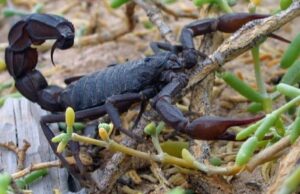
Credit: Per-Anders Olsson |
- There is a pair of dorsal eyes and two to five smaller pairs of lateral eyes.
- There are four pairs of walking legs.
Life Cycle and Common Characteristics
- The courtship starts with the male grasping the female’s pedipalps with his own; the pair then perform a special dance.
- When the male identifies a suitable location, he deposits the spermatophore and then guides the female over it. This allows the spermatophore to enter her genital opercula, which triggers the release of sperm, thus fertilizing the female.
- The mating process can take from 1 to 25 hours and depends on the ability of the male to find a suitable place to deposit his spermatophore.
- Once the mating is complete, the male and female separate. The male retreat quickly to avoid being cannibalized by the female (although sexual cannibalism is infrequent with scorpions).
- Scorpions are viviparous (born live). The young are carried about on their mother’s back until they undergo at least one molt.
- Before the first molt, scorplings cannot survive naturally without the mother, since they depend on her for protection and to regulate their moisture levels.
- The size of the litter depends on the species and environmental factors and can range from 2 to 100 scorplings. The average litter consists of around 8 scorplings.
- The young generally resemble their parents.
- A scorpion’s developmental progress is measured in instars. This scorpion requires 5 to 7 molts to reach maturity.
- The process of hardening is called sclerotization. The new exoskeleton does not fluoresce, but the fluorescence gradually returns.
- Scorpions are known to glow when exposed to certain wavelengths of ultraviolet light due to the presence of fluorescent chemicals in the cuticle.
- They live in the ruins of neglected structures.
- This scorpion is found in a wide range of habitats. It is reported from rural areas or suburbs which are in the fringes of the desert. It also occurs in margins of the desert (arid, semi-arid) places and sometimes accumulated vegetation debris. On sandy areas, they make their burrow under the fire bushes. It is rare in the city.
- A nocturnal scorpion, it hides in crevices and under objects during the day, and at night hunts insects and other invertebrates, or small lizards.
Damages and Economic & Medical Implications
- Scorpions can be dangerous (even fatal) for humans.
- Venom has LD50 in mice of 0.32 mg/kg, which makes the scorpion among the most toxic species in the world. Children are most at risk from the effect of the stings due to their body mass.
- Victims of the sting have reported local effects (intense pain, redness, and swelling).
- Systemic effects include heart malfunctions, remote internal bleeding, visual disturbance, and respiratory problems.
- Deaths mostly occur with shock, respiratory arrest, and heart failure.
- The venom is composed of neurotoxins, cardiotoxins, and myotoxins.
- If you are stung by this species of scorpions, regardless of age or size, medical assistance should be sought as soon as possible
B – Black Sting Scorpion
General Description
| · Black sting scorpion is golden and brown in color with a black string.
· Thin elongated pincer-like pedipalps, jointed abdomen which ends in a swollen black sting. · Antennae are absent and the mouthparts are formed by small pincer-like chelicerae (fangs). · There is a pair of dorsal eyes and two to five smaller pairs of lateral eyes. · There are four pairs of walking legs. The legs are hair-covered and end in hooks that are used to hold onto vegetation. |
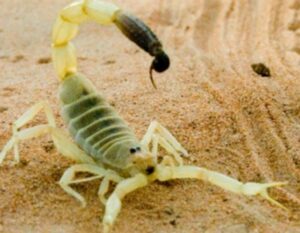
Credit: R. Ingram, ddcr.org |
Life Cycle and Common Characteristics
- The courtship starts with the male grasping the female’s pedipalps with his own; the pair then perform a special dance.
- When the male identifies a suitable location, he deposits the spermatophore and then guides the female over it. This allows the spermatophore to enter her genital opercula, which triggers the release of sperm, thus fertilizing the female.
- The mating process can take from 1 to 25 hours and depends on the ability of the male to find a suitable place to deposit his spermatophore.
- Once the mating is complete, the male and female separate. The male retreat quickly to avoid being cannibalized by the female (although sexual cannibalism is infrequent with scorpions).
- Scorpions are viviparous (born live). The young are carried about on their mother’s back until they undergo at least one molt.
- Before the first molt, scorplings cannot survive naturally without the mother, since they depend on her for protection and to regulate their moisture levels.
- The size of the litter depends on the species and environmental factors and can range from 2 to 100 scorplings. The average litter consists of around 8 scorplings.
- The young generally resemble their parents.
- A scorpion’s developmental progress is measured in instars. This scorpion requires 5 to 7 molts to reach maturity.
- The process of hardening is called sclerotization. The new exoskeleton does not fluoresce, but the fluorescence gradually returns.
- Scorpions are known to glow when exposed to certain wavelengths of ultraviolet light due to the presence of fluorescent chemicals in the cuticle.
- They are found mostly in rocky areas. On sandy areas, they make their burrow under the fire bushes.
Damages and Economic & Medical Implications
- Scorpions can be dangerous (even fatal) for humans. Their poison or venom is used to kill or paralyze their prey so that it can be eaten.
- Silverfish
Common Silverfish
General Description
| · Silverfish are among the most common household insects around the world.
· Silverfish is also called Hairy Tail. · Adults are very small, oblong, wingless insects, and range from 1.3 to 2.5 cm in length. · The antennae are long and slender.
|

Credit: Christian Fischer |
- The body is flattened, long and slender, broad at the front and tapering gradually toward the rear. The body is covered with soft scales that give the insect a shiny appearance.
- At the end of the body there are three long appendages (two pairs of anal horns and one medial). These give rise to the common name “bristletails.”
- The mouth parts are biting, and the antennae are long threadlike antennae consisting of several segments. Compound eyes are small. The firebrats are gray or brownish.
- The young look like small adults, and their development takes place by gradual metamorphosis.
- Eggs are oval-shaped, whitish, about 0.8 mm long,
Life Cycle and Common Characteristics
- Silverfish are most active at night and can run very swiftly.
- They are found almost anywhere in a house, especially in areas of high moisture close to their source of food.
- After mating, females lay eggs in protected areas or near food sources, such as behind baseboards, in small clumps of 2-10 eggs. They usually lay fewer than 100 eggs in their lifetime.
- Eggs hatch in about 30 days into nymphs, depending on temperature and humidity.
- Adults live for about 3 months.
- Insects have the ability to molt continuously, and the number of molts during their lifetime may reach 60 molts.
- They live in warm places like kitchens and laundry rooms, around ovens, boilers, and hot water pipes, and they are also found in storage rooms.
- They hide in cracks and corners of wood, especially damp ones, behind cupboards and pictures, on wooden floors, under plant leaves, dry grass, stones, and in the soil. The spread of the second type increases in damp places, such as in basements, toilets, and adjacent rooms.
- Nocturnal insects, flee quickly when they sense danger and avoid light, and their activity increases in summer.
- Silverfish eat a wide variety of foods containing proteins or carbohydrates.
- Silverfish can survive for long periods of time without food, including rolled oats, dried beef, flour, starch, paper, cotton, some synthetic fibers, sugar, beef extract, dead insects, glue, paste, and linen.
- They have the ability to digest cellulose.
- Silverfish are unable to reproduce, or even to survive in buildings where winter heating and moisture loss result in low relative humidity.
- In protected conditions, silverfish have a very long lifespan and can live between 6 and 8 years.
Damages and Economic & Medical Implications
- Silverfish cause damage to s some natural and synthetic fibers, drapes, and the glossy surfaces of pictures, adhesive and glutinous materials, leather, stuffed animals and birds, wallpapers glued with glue and starch, books and other paper products, and starchy foods.
- Silverfish are primarily nuisance insects.
- They consume small amounts of human foods and contaminate them with their body scales and droppings.
- Spiders:
A – Red Back Spider or Back Widow Spider
General Description
|
Credit: Laurence Grayson |

Credit: William |
- Adult female redback spiders usually have a body length of 10 to 15 mm long, while the male is much smaller, being only 3-5 mm long.
- The female is recognized by her spherical black body with a prominent red stripe on the upper side of her abdomen and an hourglass-shaped red/orange streak on the underside.
- Males are light brown, with white markings on the upper side of the abdomen and a pale hourglass marking on the underside.
- Occasionally, markings or the female black abdomens may occur.
- The cephalothoraxis much smaller than the abdomen, and is black.
- Redback spiderlings are grey with dark spots and become darker with each molt.
- Juvenile females have additional white markings on the abdomen.
- The bright scarletred colors may serve as a warning to potential predators.
- The spider has a pair of venom glands, one attached to each of its chelicerae with very small fangs.
Life Cycle and Common Characteristics
- The female black widow spiders take about 2-3 months to mature.
- After mating the females kill the male.
- Females lay eggs and create egg sacs (each containing up to 300 eggs) to keep them safe in. Most of the hatchlings do not survive because they are eaten by their siblings or by wasp parasitism.
- The young spiders hatch from the eggs after 8 days and emerge from the egg sac after 11 days of egg laying.
- After emerging the young from the eggs they mature for in 2-3 months, and molt 3-8 times until they reach adulthood.
- They build irregularly shaped webs that they rarely leave.
- Females may live for 2 to 3 years, whereas males only live for about 6 or 7
- Spiders reside in dark, dry areas such as logs or under rocks.
- Spiders are carnivorous eating small insects that are caught in their webs. They also eat skinks and juvenile mice, snakes, and frogs.
Damages and Economic & Medical Implications
- Only female redback widow spiders are venomous. Males are hardly seen and are completely harmless to a person.
- The venom affects the nervous system of the victim. Symptoms of poisoning occur quickly and include shock, chills, stomach cramps, fever, nausea, headache, high blood pressure, difficulty breathing, and sweating.
- One has to be careful when picking up waste, as he rarely feels its sting, but he realizes it recently when the wound site is swollen and two small spots appear at the site of the fangs penetrating the skin. The sting pain is excruciating and runs throughout the body, especially the legs.
- The bite of this spider is serious but rarely leads to death.
- Most bite victims fully recover within two days.
- Redback widow spiders are also beneficial spiders because they help to keep populations down of other spider species and nuisance insects by feeding upon them.
B – Common House Spider
General Description
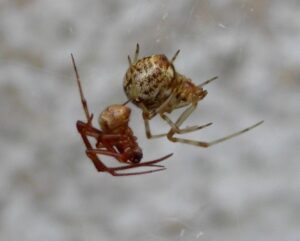
A male and female (the female is the larger of the two). Credit: Calibas |

Credit: Patrick Moran |
- Common house spiders are tan to nearly black, with patterns of shades on their body.
- Females are 5 and 6 mm long, and males are 3.8 and 4.7 mm long.
- Males have a less bulbous abdomen than females.
- The size and coloration allow the spiders to blend into the background and escape notice.
Life Cycle and Common Characteristics
| · This species lives for more than a year after reaching maturity.
· Females suspend their egg sacs in their webs; the spherical egg sacs have a tan papery outer layer. · Each egg sac contains 150–200 eggs, and a single female produces 15–20 egg sacs in its lifetime. · Spiderlings remain in the mother’s web for several days after emerging from the egg sac. · The spiderlings molt and develop before they become adults. |
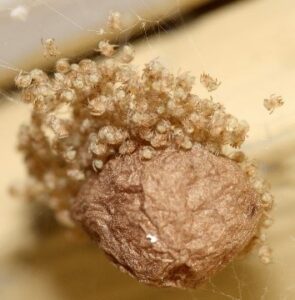
Recently hatched egg sac. The spiderlings atop the hatched egg sac are likely 3 days old and roughly the size of a pepper grain each. Credit: Richhoyer99 |
- Spiderlings molt 6 times for males and 7 times in females.
- Spiders overwinter (as either adults or eggs) inside houses, sheds garages, hollow logs, or underneath rocks.
- Both males and females share the same web for long periods.
- They are found hiding in the corners of doorways, in closets, in clothing and shoes, underneath furniture, and in basements attics.
- They have poor vision and cannot detect any movement more than 7 to 10 cm away
Damages and Economic & Medical Implications
· The house spider is the spider most often encountered in human-dwelling places. They are not aggressive and let a human hand approach their webs. It is considered to be a nuisance pest, probably more because of its webs than the spider itself.
- They bite humansonly in self-defense when grabbed and squeezed.
- House spiders have neurotoxic Their bites are less severe than that of other theridiids and are “not known to be dangerous to humans”.
- They are natural predators of many other pests, including houseflies and mosquitoes.
- Springtails or Snow Fleas:
Common Springtail
General Description
| · Springtails (Collembola) are very small, primitive, elongated, 1 to 10 mm in length, and have moderate- length antennae. Springtails and fleas may be of the same size, but have differences in their structure.
· They are dark-colored, brown, grey or, black. Some species may be white and some are even brightly colored. |
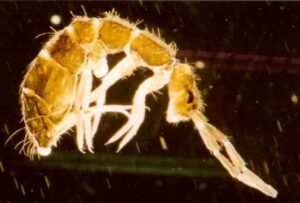
Credit: U. Burkhardt |
- Springtails do not have wings and cannot fly. But they can jump up to several centimeters using a special forked structure under the abdomen.
- They have a forked appendage (furcula) attached at the end of the abdomen and held in place under a clasp-like structure formed by a pair of appendages. The furcula provides a jumping apparatus for the collembolan.
- Springtails also have a ventral abdominal, suckerlike tube (collaphore), which secretes a sticky, adhesive substance and also takes up water.
Life Cycle and Common Characteristics
- The young hatch from spherical eggs and closely resemble the adult.
- There can be 3 to 12 molts before maturity and up to about 50 molts during the lifetime of a springtail.
- In areas with sufficient vegetation, around air conditioning condensate lines, Springtails are very common. They tend to grow faster in soil, algae, decaying plant matter, and bacteria and are predators of small soil animals and a few tender plants.
- Collembolans are omnivorous, free-living organisms that prefer moist conditions. They do not directly engage in the decomposition of organic matter but contribute to it indirectly through the fragmentation of organic matter and the control of soil microbial communities.
- Springtails live in soil and on water and feed on fungal hyphae and spores, decaying vegetable matter, logs, plant materials and pollen, animal remains, colloidal materials, mushrooms, minerals, and bacteria.
- Springtails are found indoors and outdoors. Outdoors, are found feeding on fungi, pollen, algae or decaying organic matter. When they are close to the home, they may move indoors. Indoors, they are in areas of high moisture and condensation (around plumbing leaks in bathrooms, basements and kitchens). They are also found in the soil of overwatered houseplants.
Damages and Economic & Medical Implications
- Springtails do not cause structural damage and virtually pose no serious threat to the house owner. They tend to feed on fungi and decaying matter.
- They cause severe damage to agricultural crops.
- Wasps:
A – Paper Wasp – Polistes dominula Christ
General Description
| · Paper Wasps or umbrella wasps get their name from the paper-like material that they use to create their umbrella-shaped nests.
· They have a narrow body and pinched waist, 1.5-2.5 cm long, and colored bright yellow with alternating black, · Wings are grayish in color, and the length of the wings in males ranges from 0,9 to 1.3 cm, while those of females range from 0.8 to 1.2 cm. |
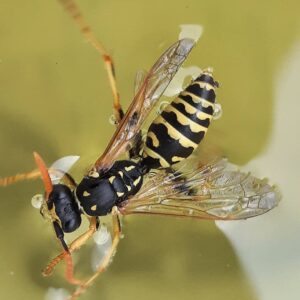
Credit: Garnhami |
- Females have yellow, comma-shaped scutal spots.
- Females have a black subantennal mark that rarely has a pair of small, yellow spots.
- The female mandible is black and sometimes has a yellow spot.
- Males are often distinguished from female wasps by their curled antennae and lack of a stinger.
Life Cycle and Common Characteristics
- Overwintering females are fertilized and emerge to build a nest.
- The queen starts laying eggs in late March or early April.
- Larvae, after egg hatching, develop into female workers that help to take care of the single queen. Workers care for the eggs and larvae and forage for food.
- The existing queen starts producing males and new queens in the late summer. Then the males die off after mating and the newly fertilized queens overwinter.
- The queen survives the winter by hibernating behind the bark of trees, until the next spring when they emerge to start the reproductive cycle over again.
- Queens live longer than the males or the workers.
- Workers protect the queens from predators.
- The life cycle is shorter than a year.
- Paper wasps chew on wood and mix it with their saliva in order to create the paper-like material that they make their nests from.
- It was recently discovered that a paper wasp has the ability to recognize faces.
- The relatively high productivity of the paper wasp is correlated to the timing of its brood development. They have a short brood developmental time.
Damages and Economic & Medical Implications
- Paper wasps are beneficial insects. They feed on nectar and pollen and have a role in pollinating crops and plants. They also prey on nuisance insects.
- In urban areas, they colonize nearby human civilizations because man-made structures can act as great shelters and also are located close to the resources such as food.
- The paper wasp has a sting but is not aggressive, and will usually attack only to defend itself or the nest. Its sting can cause excessive sensitivity to some people, so the majority of people do not welcome it as a neighbor close to their homes.
- The venom from a paper wasp sting can cause a severe allergic reaction in some people that requires immediate medical attention to prevent serious consequences.
B – Oriental Wasp – Vespa orientalis Linnaeus
General Description
| · The adult insect is about 2.5-3 cm long.
· The general color of the body is reddish-brown, and the wings are yellowish-brown. The faces are yellow, as are the posterior margins of the second, fourth, and fifth ventral segments. · The male’s abdomen consists of seven segments, while the female’s abdomen consists of only six. · The antennae consist of 13 segments in the male and 12 segments in the female. |
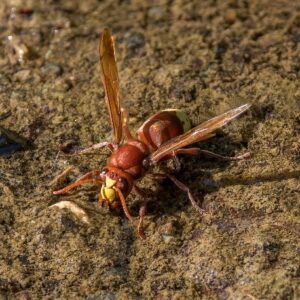
Credit: Charles J. Sharp |
- The male is smaller than the queen but equal to the worker in size.
- The wasp nest consists of a queen, who is the only fertile female who lays eggs, some males who mate with the queens and fertilize them, and the workers, who are females and are usually sterile, and the workers may sometimes lay unfertilized eggs when the queen dies before the end of the season. There may be several queens in one nest.
Life Cycle and Common Characteristics
- The fertilized queens appear in early March, and their number increases in April. These queens build their nests and take the walls of abandoned houses or the ground as places for them.
- The eggs are laid in cells of mud, and when the larvae are fully grown, they turn into a virgin. At the end of the virgin phase, which takes 12 days, the full insect emerges.
- The number of worker bees increases from August to November (and reaches its maximum number in October and then decreases).
- At the end of summer, queens and males appear, and males arise from unfertilized eggs, then fertilization of these virgin queens occurs in late autumn (October and November). Colony, where all males, workers, and the queen’s mother died. The fertilized queens emerge from their nests in the early spring of the following year to repeat the life cycle.
- Oriental wasps are restricted to areas with underground cavities which can be exploited as nesting sites. In urban areas, nests are found in cavity walls, subfloor crawl spaces, roof spaces, and in outdoor stockpiles of goods such as building materials.
- The peak size of the colony is a few thousand individuals and a colony typically contains three to six combs, each containing 600-900 individual cells.
- Wasps that attack honey bee colonies live socially in the form of colonies inside nests containing hexagonal sells, where they build their nests from leaves or mud under or above the surface of the earth or in cracks in buildings or canal bridges.
- They are stinging insects, and under normal conditions, they feed on the nectar of flowers and collect other insects that they capture in order to feed their young.
- Oriental hornets communicate through sound vibrations.
Damages and Economic & Medical Implications
- Oriental wasps are among the pests that exist in apiaries in many countries.
- The adult attacks bee hives and causes the death of a large number of their workers.
- Venom is regarded as a potential therapeutic agent.
- Water Boatman
Leasse Water Boatman
General Description
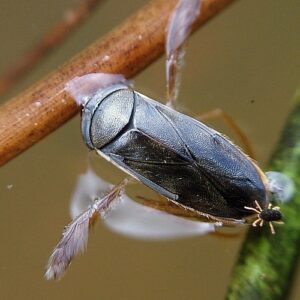
Credit: Andy Reago |
Credit: Piet Spaans |
- It is a water-dwelling insect.
- Adults have a long, flattened body ranging from 0.5 to 1.5 cm long. They have fine dark brown or black striations marking the wings.
- They have 2 short front legs and 4 long rear legs. · Its body resembles the shape of a boat and the forelegs are covered with hairs and shaped like oars, hence the name “water boatman”.· They also have a triangular head and short mouthparts.
Life Cycle and Common Characteristics
- Adults overwinter.
- Eggs are laid, between January and April, on the stems of aquatic plants.
- Eggs are deposited on submerged plants, rocks, or sticks, but eggs fail to hatch above 0.5% salinity.
- The larval stage lasts for 3 to 4 months.
- First adults appear in July.
- They are found in household pools, ponds, brackish water, and slow-flowing rivers, usually in neutral to alkaline water.
- They are omnivorous insects and feed on aquatic plants, algae, and animal materials.
- They have long and strong hind legs which they use to swim and float on the surface of the water
- They swim right side up (unlike the backswimmers who swim upside down).
- They breathe oxygen by trapping air beneath their wing cases (oxygen is trapped by tiny hairs).
- They are herbivores and swim on their fronts.
- There are 1 to 2 generations per year.
- They are strong flier and readily migrates if conditions become unsuitable.
Damages and Economic & Medical Implications
Leasse Water Boatman is considered to be an annoying pest, especially in swimming pools.
- Yellowjackets:
German Yellowjacket or German Wasp
General Description
| · Yellowjackets are are sometimes mistakenly referred to as paper wasps because they build grey paper nests.· They are 1.3-1.5 cm long, black and yellow in color.
· The body is slightly wider than the head. |
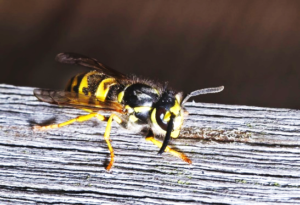
Credit: pjt56 |
- There is a yellow band behind the compound eye.
- The face has three small black spots, and the antenna is long and black.
- The dorsal surface of the thorax is black with no stripes down the middle.
- The abdomen of the female has 6 segments and 7 segments in the male.
- The legs are yellow, and the wings are clear.
Life Cycle and Common Characteristics
- The queen emerges from hibernation and initiates a nest in the spring.
- The queen mates with up to 7 males.
- The colony grows rapidly during the summer (July and August) with an increase in worker numbers and nest size (more than 4,000 wasps, and more males than workers).
- The old queens die off in the fall and the colony collapses, and the new queen begins hibernation.
- The nests may survive through the winter and reach the next season.
- Yellowjackets are found in ponds, lakes, and swimming pools.
- They enter yards because they smell food (meats and sweets) or other attractants (pests attracting to grills and waste cans in outdoor picnics).
- Workers can be predators and scavengers.
- They are efficient at hunting for small, live food sources.
- As scavengers, they make many trips between the location of the nest and the food source.
Damages and Economic & Medical Implications
- The species is considered a public health threat in urban areas.
- Yellowjackets do not cause structural damage to homes. They may build nests in attics or walls and chew through drywall to enter living spaces.
- They defend themselves if disturbed.
- They are aggressive defenders of their colonies.
- They are not quick to sting, but their sting is painful. Each insect may sting several times.
- Stings induce severe allergic reactions.
- Severe pain or burning at the site lasts 1 to 2 hours.
- No deaths are attributed to yellowjackets.


